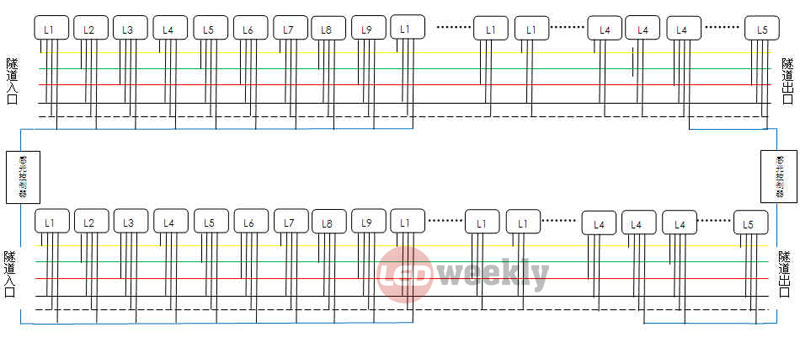Energy-saving research on new light sources for tunnel applications has attracted industry attention, and energy-saving research on LED tunnel lights has made significant progress. Because LED is used in tunnel lighting according to the scientific research results of Ming Vision and intermediate vision theory, color rendering and illumination, LED lighting tunnels have been used in many important tunnel lighting projects in China. The application of LED tunnel luminaires in tunnel lighting projects has made breakthroughs, but there are still problems. For example, there are no specific design and construction specifications for tunnel luminaires with LED as the light source, and product performance is uneven. 60% of the tunnels in Europe are in Italy. This case is the actual application of a tunnel in Rome, Italy.
JL-066-08-1 type LED tunnel light, the LED we have used has been increased to 1W 90~105Lm, the current voltage is 3.2V, we still use 320hA power supply, so the actual working power of 1 LED is 1.024W The total power of 66 light sources is 67.6W, our power conversion efficiency is 86%, so the total power is 78.6W, the total length of the 736m tunnel is 103ç›, and the total power is 103×78.6=8095.8W.
Calculated by working 24 hours a day, the total power consumption is about 194.3 kWh, and the year is about 70,920 kWh.
Since I did not receive the installation diagram of the original tunnel light before, I always thought that the tunnel length was 700 meters to design, and now the actual length is 736 meters. For this reason, I have made another adjustment, and considering the vicinity of the hole. Tunnel lights are intelligently controlled by their brightness rather than the direct nighttime closure of conventional sodium lamps, so the overall lamp mounting density must be re-adjusted to the needs of the floor's brightness. The installation layout of the original sodium lamp will form three brightness areas when the glare lamp is turned on. The high brightness area is 0~30 meters from the hole, the brightness is 80Lux, the medium brightness area is 30~60 meters, and the brightness is about 50Lux. 60~96 meters for the transition area is about 40Lux, the middle area of ​​the tunnel is low-luminance area, the brightness is about 30Lux, when the night light is off, the whole tunnel is all low-brightness area, the brightness is about 30Lux.
After adopting the tunnel LED transformation, a total of 40 lamps at the entrance and exit of the tunnel will adopt intelligent control of its brightness to control its brightness. A total of 63 lamps will be used for all-round power work. The total number of lamps is 103ç›, before The design should be 7 more. The specific method is that a light-sensing controller is installed in the entrance and exit of the tunnel to collect optical signals, and the optical signal directly controls the brightness of the 40-inch tunnel light of the tunnel entrance and exit. When the light is good during the day, the whole power is used, and the half power is used at night. The brightness varies with the brightness of the external environment. The controller does not consume power. When the light outside the tunnel is good during the daytime, the light at the tunnel port will work at full power. The brightness at this time basically meets the requirements of 80, 50, 30 Lux. After half-power operation of the tunnel portlight at night, the brightness of the hole is about 40 Lux, and the tunnel is still 30 Lux. If you don't need the brightness to change with the external environment, you can set the fixed time and change its brightness. Schematic diagram of installation and wiring of tunnel lights:
